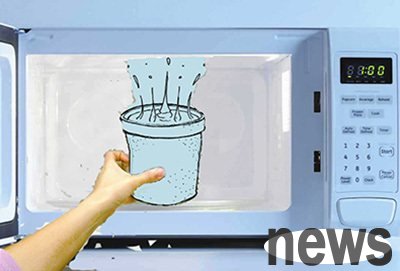
A friend sent an email, which was a story that looked like a thrilling movie, saying that someone burned his face and blinded his eyes because he boiled water in microwave. So, I went online and saw that there were really a lot of English and Chinese articles and videos warning everyone not to use microwave boiling water, such as microwave boiling water for Chinese news? Internet flow will spray!
Most of these articles and videos say that microwaves can cause water temperature to rise continuously, but they will not cause boiling, which will form the so-called superheating phenomenon. In other words, although the water temperature has exceeded 100 degrees Celsius, it still looks calm and unwavering. However, once the microwave is turned on and the water cup is picked up, the water will suddenly spray, causing damage.

, when pure water is heated in a clean cup with microwave, there is no surface that can allow bubbles to adhere, so even though the water temperature continues to rise, there will be no boiling phenomenon. However, once this super-heated water is slightly shaken, a large number of bubbles will immediately form, causing instant spraying. This is why those online articles and videos tell everyone not to cook water in microwave. However, some articles and videos will also say that if you want to cook water in microwave, you need to put a wooden mixing stick in the water cup, and this mixing stick can provide the surface where the bubbles are attached to, thereby avoiding the occurrence of super-heat phenomena.
However, based on my habit of making tea, boiling water in microwave can be said to be the only option. If you use a fire or electric stove to boil water, it will be like picking teeth with chopsticks, which is both clumsy and wastes time and energy. Fortunately, for nearly 30 years, I have been cooking tea in the office every day in microwave water, and I have to cook about ten times a day. I have never used a mixing stick, but I have never had any problems.
My habit is to put the tea leaves into a small pottery pot, then add the microwaved water to the pottery pot, and then pour the slightly soaked tea back into the cup where I was boiled, and then I can enjoy this small cup of tea. From 8 am to 5 pm, I repeat this whole tea making process every hour, and it gives me a little bit of a sense of luck. First, I can drink fresh tea from Hot Teng, and second, I can leave my seat every once in a while and stand up to exercise my muscles and bones.
My method is actually very simple: (1) Use a porcelain cup with ears, zippers, about 10 cm in height and straightness, (2) Put about about one-third of the water in the cup, (3) When the zipper vibrates slightly and makes a sound (about 40 seconds), turn off the microwave oven, (4) Do not clink the cup when taking out the cup, but hook the ear of the cup with your index finger, slowly pull it out the microwave oven, (5) After taking out the cup, tilt it forward slightly (to avoid steam from rushing to the face), then open the cover, and pour hot water into the pottery. That's all.
Maybe when you see "heating until the cushion vibrates slightly and sounds", you will think in your heart: Doesn't this mean there is steam? Then, this means that there is bubble formation, so it means that the superheat phenomenon has not occurred. Regarding this, our personal experience is that super-heat phenomena may occur, but hot water will eventually produce gas. In other words, superheat phenomena are transitional and will not be endless. Since the water in the cup is only one-third full, there is enough space to squeeze the possible spray. Also, since I use the cup where I drink tea to boil water, there will be some tea stain or tea leaves in the cup, and these chaotic substances can provide the surface needed for bubble formation. In other words, it is almost impossible for me to have super hot phenomena when I boil water.
Also, I would like to say that I used to cook water in mugs (mugs) in microwaves, and the purpose was mostly to soak tea bags. In other words, I used porcelain cups without cushions, and the water was added to 90%. Of course, this is very different from the sketch I mentioned above to make tea leaves. In this case, I will set the time to boil water to avoid excessive water temperature. I will also be very careful when taking out the cup and putting the tea bag in it. But I must say that I have witnessed that when I put the tea bag in, the water on the surface of the cup instantly sizzled, that is, it was sprayed in an instant. So, be careful.
No matter what, the above is our experience in the past 30 years, which has been boiling water in microwaves many times, and has never had any problems. However, I can't guarantee that no one will have any problems. So, please consider whether to follow my method and be responsible for it.
Original text: Never use microwave to boil water?